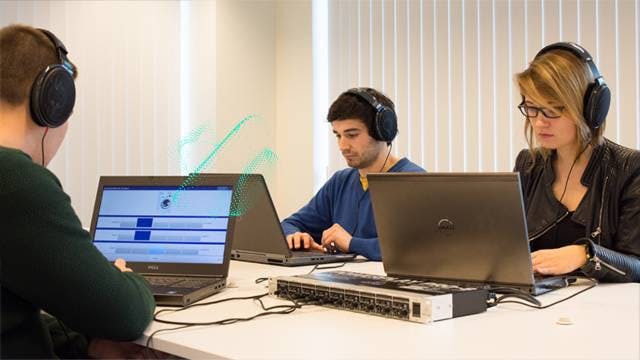제품 사운드는 고객이 구매를 결정하는 데 큰 영향을 미칠 수 있습니다. 올바른 브랜드 가치를 전달하는 데는 엔지니어링 문제뿐만 아니라 인간의 심리도 중요합니다.
사람들은 자신의 개인적인 취향에 따라 제품의 사운드를 평가합니다. 예를 들어, 소음 엔지니어링 팀에 속한 두 명의 동료는 진공 제품의 사운드가 듣기 좋은지 여부에 대해 의견이 다를 수 있습니다. 이러한 상황으로 인해 사운드가 더 훌륭한 제품의 개발을 진행하는 데 어려움을 겪습니다.
심사단 테스트는 가장 적합한 제품 설계를 판단할 수 있도록 청취자 집단(비즈니스 전문가, 미래 고객, 경영진)이 사운드에서 느낀 주관적인 인상을 평가하는 방법입니다.
본 웨비나를 통해 엔지니어 및 제품 설계자는 다음과 같은 내용에 대해 알아볼 수 있습니다.
- 사운드 샘플 준비
- 심사단 인원수 선택
- 제품의 특정 요구사항을 충족하는 심사단 테스트 설계
- 결과 해석
실제로 어떻게 진행됩니까?
심사단은 청취 테스트 과정에서 일련의 사운드를 듣게 됩니다. 예를 들어 일련의 사운드 페어를 비교하는 테스트를 수행할 수 있습니다. 그런 다음 심사단은 사운드 A와 사운드 B의 선호도에 대한 질문을 받습니다. 더욱 심도 깊은 조사를 위해 사운드를 '강함', '안정적임' 또는 '듣기 좋음'으로 분류할 수 있습니다. 그 다음으로 제시된 범주에 따라 사운드를 평가합니다.
선호도 평가 결과나 가장 지배적인 특성은 테스트 프로토타입 사양 또는 음질 메트릭 등 보다 객관적인 측정 기준과 서로 연관이 있을 수 있습니다.
어디에 심사단 테스트를 이용할 수 있습니까?
사실 소리가 나는 물체라면 무엇이든 테스트할 수 있습니다. 가장 일반적인 사용 사례는 자동차 산업입니다. 엔진 소리나 문 닫는 소리, 자동식 창문 소리 등 고객의 행동으로 인한 소리가 리드미컬한지, 듣기 좋은지 평가하여 개선점으로 삼을 수 있습니다. 자동차 산업 이외에도 몇 가지 예를 들어 트럭의 냉각 장치, 식기 세척기, 커피 머신, 잔디깎이에 대한 주관적인 사운드 선호도를 자주 조사합니다.
음질 루프 해소
제품 음질 검증 프로세스는 심사단 테스트로 마무리됩니다. 음질 메트릭 등의 객관적인 측정 기준과 심사단의 주관적인 의견을 연결하여 훨씬 수월하게 제품의 사운드를 만들고 개선할 수 있으며, 이는 결과적으로 고객이 인정할 수 있는 브랜드를 창출합니다.
발표자 소개

Agnieszka Oltarzewska
음향 부문 제품 관리자
Agnieszka Oltarzewska는 Siemens Digital Industries Software의 음향 부문 제품 관리자입니다. Agnieszka는 폴란드 Wroclaw University of Technology에서 음향학 석사 학위를 받았습니다. 현재 벨기에 루벤에 거주하면서 음질 엔지니어링 및 음향 재료 특성화에 대한 산업 전반의 솔루션을 중점적으로 다룹니다.
